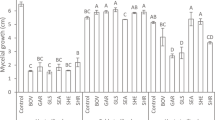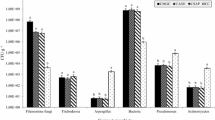Abstract
Manure-straw mixtures were composted and water extracts, made by incubating compost in water for 3 to 18 days, were assessed for antagonistic activity against Botrytis cinerea, using a range of tests. Extracts of all ages inhibited conidial germination on glass slides and reduced mycelial growth on agar. Mixing extracts of all ages with droplets of suspensions of B. cinerea conidia on detached Phaseolus bean leaves suppressed lesion development, but only 3- to 8-day-old extracts had an effect when sprayed onto leaves 2 days before inoculation. Extracts contained a large and varied microbial population of actinomycetes (0.3 to 2.4×105 c.f.u.ml−1), bacteria (1.5 to 5.6×1010 c.f.u.ml−1), filamentous fungi (25.0 to 45.5 c.f.u. ml−1) and yeasts (26.1 to 62.6 c.f.u.ml−1). Eight- and 18-day-old extracts lost activity completely on filter sterilization or autoclaving. Weekly sprays of 8-day-old extracts onto lettuce in the glasshouse had no effect on the incidence of grey mould, but significantly reduced its severity and increased marketable yield. The use of compost extracts in biocontrol of plant diseases and their possible mode of action is discussed.
Similar content being viewed by others
References
Barnett, J.A., Payne, R.W. & Yarrow, D. 1983 Yeasts; Characteristics and Identification. Cambridge: Cambridge University Press.
Bollen, G.J. 1993 Factors involved in inactivation of plant pathogens during composting of crop residues. In Science and Engineering of Composting: Design, Environmental, Microbiologial and Utilization Aspects, eds Hoitink, H.A.J. & Keener, H.M. pp. 301–318. Washington DC: Renaissance.
Challen, M.P. & Elliott, T.J. 1986 Polypropylene straw ampoules for the storage of micro-organisms in liquid nitrogen. Journal of Microbiological Methods 5, 11–23.
Dennis, C. & Davis, R.P. 1979 Tolerance of Botrytis cinerea to iprodione and vinclozolin. Plant Pathology 28, 131–133.
Domsch, K.H., Gams, W. & Anderson, T.H. 1980 Compendium of Soil Fungi, Vols. 1 & 2. London: Academic Press.
Dubos, B., Jailloux, F. & Bulit, J. 1982 L'antagonisme microbien dans la lutte contre la pouritture grise de la vigne. Bulletin OEPP 12, 171–175.
Elad, Y., Yunis, H. & Katan, T. 1992 Multiple fungicide resistance to benzimidazoles, dicarboximides and diethofencarb in field isolates of Botrytis cinerea in Israel. Plant Pathology 41, 41–46.
Fletcher, J.T. & Griffin, M.J. 1981 The sensitivity of populations of Erysiphe graminis to triademefon and Botrytis cinerea to iprodione. Netherlands Journal of Plant Pathology 87, 239.
Katan, T. 1982 Resistance to 3,5-dichlorophenyl-N-cyclic imide (‘dicarboximide’) fungicides in the grey mould pathogen Botrytis cinerea on protected crops. Plant Pathology 31, 133–141.
Katan, T., Elad, Y. & Yunis, H. 1989 Resistance to diethofencarb (NPC) in benomyl-resistant field isolates of Botrytis cinerea. Plant Pathology 38, 86–92.
Ketterer, N. 1990 Untersuchungen zur Wirkung von Kompost-Extrakten auf den Blattbefall der Kartoffel und Tomate durch Phytophthora infestans sowie auf den Befall der Weinrebe durch Plasmopara viticola, Pseudopeziza tracheiphila und Uncinula necator. Dissertation, University of Bonn, Germany.
Leach, C.M. 1971 A practical guide to the effects of visible and ultraviolet light on fungi. Methods in Microbiology 4, 609–664.
Leone, G. & Tonneijck, A.E.G. 1990 A rapid procedure for screening the resistance of bean cultivars (Phaseolus vulgaris L.) to Botrytis cinerea and Sclerotinia sclerotiorum. Euphytica 48, 87–89.
Lynch, J.M. 1993 Substrate availability in the production of composts. In Science and Engineering of Composting: Design, Environmental, Microbiological and Utilization Aspects, eds Hoitink, H.A.J. & Keener, H.M. pp. 301–318. Washington DC: Renaissance.
Malathrakis, N.E. 1989 Resistance of Botrytis cinerea to dichlofluanid in greenhouse vegetables. Plant Disease 73, 138–141.
Maude, R.B. 1980 Disease control. In The Biology of Botrytis, eds Coley-Smith, J.R., Verhoeff, K. & Jarvis, W.R. pp. 275–308. London: Academic Press.
McLaughlin, R.J., Wilson, C.L., Droby, S., Ben-Arie, R. & Chalutz, E. 1992 Biological control of postharvest diseases of grape, peach and apple with the yeasts Kloeckera apiculata and Candida guilliermondii. Plant Disease 76, 470–473.
McQuilken, M.P., Whipps, J.M. & Lynch, J.M. 1993 Some effects of water extracts of compost on Botrytis cinerea. In IOBC/WPRS Bulletin “Biological Control of Foliar and Post-harvest Diseases”, eds. Fokkema, N.J., Köhl, J. & Elad, Y. IOBC/WPRS Bulletin, 16 (in press).
Palti, J. 1981 Cultural Practices and Infectious Crop Diseases. Berlin: Springer Verlag.
Panagiotaku, M.G. & Malathrakis, N.E. 1981 Resistance of Botrytis cinerea Pers. to dicarboximide fungicides. Netherlands Journal of Plant Pathology 87, 242.
Panayotakou, M. & Malathrakis, N.E. 1983 Resistance of Botrytis cinerea to dicarboximide fungicides in protected crops. Annals of Applied Biology 102, 293–299.
Pommer, E.H. & Lorenz, G. 1982 Resistance of Botrytis cinerea Pers. to dicarboximide fungicides in protected crops—a literature review. Annals of Applied Biology 102, 293–299.
Stindt, A. 1990 Untersuchungen zur Wirkung und zu den Wirkungsmechnismen von Kompostextrakten auf Botrytis cinerea Pers. ex Nocca & Balb an Erdbeeren, Kopfsalat und Buschbohnen. Dissertation, University of Bonn, Germany.
Stindt, A. & Weltzien, H.C. 1988a Der Einsatz von Kompostextrakten zur Bekämpfung von Botrytis cinerea an Erdbeeren-Ergebnisse des Versuchsjahres 1987. Gesunde Pflanzen 40, 451–454.
Stindt, A. & Weltzien, H.C. 1988b Der Einfluss von wässrigen, mikrobiologisch aktiven Extrakten von Kompostiertem organischen Material auf Botrytis cinerea. Mededelingen Faculteit Landbouwwetenschappen, Rijksuniversiteit Gent 53, 379–388.
Tränkner, A. 1992 Use of agricultural and municipal organic wastes to develop suppressiveness to plant pathogens. In Biological Control of Plant Diseases: Progress and Challenges for the Future, eds Tjamos, E.C., Papavizas, G. & Cook, R.J. pp. 35–42. New York: Plenum.
Tronsmo, A. 1991 Biological and integrated controls of Botrytis cinerea on apple with Trichoderma harzianum. Biological Control 1, 59–62.
Verhoeff, K., Bulit, J. & Dubos, B. 1988 Botryotinia fuckeliana (de Bary) Whetzel. In European Handbook of Plant Diseases, eds Smith, I.M., Dunez, J., Lelliot, R.A., Phillips, D.H. & Archer, S.A. pp. 432–435. Oxford: Blackwell Scientific.
Wang, Z.N., Coley-Smith, J.R. & Wareing, P.W. 1986 Dicarboximide resistance in Botrytis cinerea in protected lettuce. Plant Pathology 35, 427–433.
Weltzien, H.C. 1989 Some effects of composted organic materials on plant health. Agriculture, Ecosystems and Environment 27, 439–446.
Weltzien, H.C. 1992 Biocontrol of foliar fungal diseases with compost extracts. In Microbial Ecology of Leaves eds Andrews, J.H. & Hirano, S.S. pp. 430–450. New York: Springer-Verlag.
Weltzien, H.C. & Ketterer, N. 1986 Control of Downy Mildew, Plasmopara viticola (de Bary) Berlese et de Toni, on grapevine leaves through water extracts from composted organic wastes. Journal of Phytopathology 116, 186–188.
Additional information
M.P. McQuilken and J.M. Whipps are and J.M. Lynch was with the Microbiology and Crop Protection Department, Horticulture Research International, Littlehampton BN17 6LP, UK; J.M. Lynch is now with the School of Biological Sciences, University of Surrey, Guildford GU2 5XH, UK.
Rights and permissions
About this article
Cite this article
McQuilken, M.P., Whipps, J.M. & Lynch, J.M. Effects of water extracts of a composted manure-straw mixture on the plant pathogen Botrytis cinerea . World Journal of Microbiology & Biotechnology 10, 20–26 (1994). https://doi.org/10.1007/BF00357556
Revised:
Accepted:
Issue Date:
DOI: https://doi.org/10.1007/BF00357556




